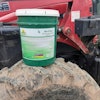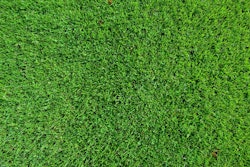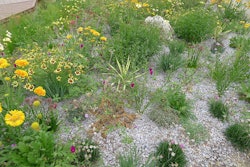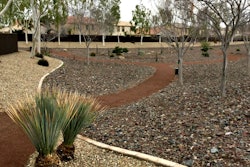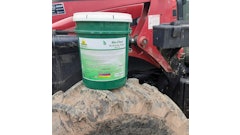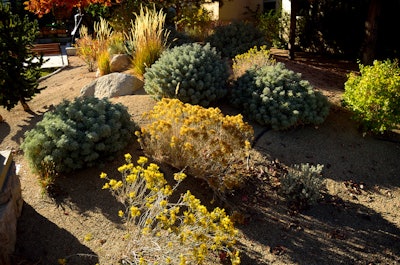
Quick—what pops into your mind when you hear the word xeriscape?
Most people think of an austere landscape consisting of cactus and stones. They may be surprised to discover that a xeriscape can just as easily be lush and green. In addition, many people incorrectly believe xeriscaping involves the complete elimination of lawns. That is not the case; and in fact, complete removal of grass is not recommended. Grass offers many environmental benefits and provides for a cooler environment. Xeriscaping can indeed provide an effective complement to lawns.
Xeriscaping: A Celebration of Climate
The word xeriscaping (coined and trademarked in the 1980s by Denver Water) comes from the Greek xeros, meaning dry, combined with landscape. However, don’t be misled by the name. Not all xeriscapes are dry.
The idea behind xeriscaping is to create a beautiful landscape while conserving water resources to the greatest extent possible. Naturally, the movement first became popular in arid regions, which is why so many people associate xeriscaped landscapes with cactus. However, it all depends on location.
In a very rainy area like Seattle, Washington, for example, a xeriscape could feature moisture-loving ferns. In Iowa, decorative grasses and bright prairie wildflowers fit the bill. And in New England, red oak, forsythia and wisteria are promising choices. Wherever your location, appropriate plants are combined with creative design to create unique landscapes with stunning visual impact. Xeriscaping acknowledges the limitations and the possibilities inherent in your unique property and location.
Why Xeriscape?
These days, people everywhere are waking up to just how precious a resource water really is. It makes sense to use it wisely. Not only is it the right thing to do for the environment, but saving water is a good financial decision as well.
Regardless of your location and climate, you can create a beautiful xeriscaped landscape on your property using the six principles of xeriscaping:
- Plan and design for smart water use. Before you start, decide what your landscape’s water resources are and how you want to use your property. Then create a plan that takes both into account. Don’t forget that hardscaped areas affect the water cycle. Consider using permeable solutions for any paved areas. A well-designed hardscape installation can also be used to direct water appropriately on your property.
- Choose plants wisely. Select plants not only for drought tolerance, but for aesthetic appeal. Aim for a good mix of plants that offer interest at various heights and throughout the year. Plants native to your area, or to a part of the world with a climate similar to yours, usually make good xeriscaping choices. Also keep in mind that different areas of your property may have differing amounts of moisture and sunlight. Choose plants accordingly.
- Improve your soil. Good soil retains moisture and encourages healthy plant growth. Incorporating organic matter, such as compost, into your soil helps improve its structure and quality. However, be aware that different plants have different soil requirements. Some natives especially don’t require much organic matter. You may want to consult a landscape professional for assistance.
- Water efficiently. As water-efficient as your xeriscaped landscape is, it may need some supplemental water from time to time. A professionally designed irrigation system can help you keep watering to a minimum, while maintaining a healthy, vibrant landscape regardless of climate.
- Mulch. A thick layer of mulch helps retain soil moisture and keeps roots cool. It also reduces weed growth and can enhance the appearance of your landscape.
- Maintain your xeriscape regularly. Once established, xeriscapes typically need minimal maintenance. However, any landscape is a dynamic system, and does require proper care to maintain aesthetic and safety standards. Pruning, fertilizing, aeration and other routine tasks should be completed on a regular schedule to keep your landscape looking picture-perfect.
The basic concepts of xeriscaping are simple. However, many different factors come into play to achieve ideal results. For instance, the interplay between landscape design, plant selection, soil care and irrigation can become far more complex when the goal is to maintain both maximum water efficiency and high aesthetics. Enlisting the help of a qualified landscaping professional with one or all of the six principles can help ensure that the xeriscape you create is truly a celebration of what is possible for your property and your climate.

